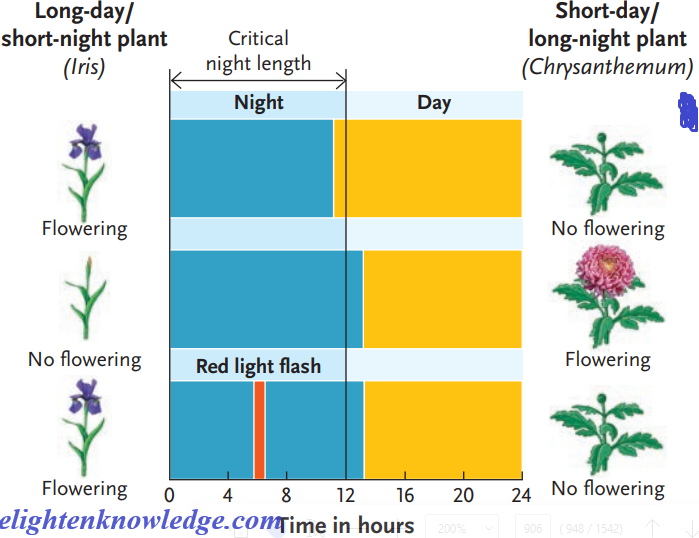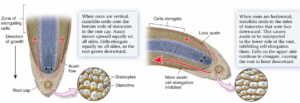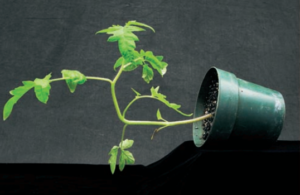Enlighten Knowledge Note on Plants Movement and Biological clock in Plants.

Introduction
All organisms sense and interact with their environments.
This is particularly true of plants.
Plant survival and growth are critically influenced by abiotic factors, including water, wind, and light.
The effect of the environment on plant growth also accounts for much of the variation in adult form within a species.
Although responses can be observed on a macroscopic scale, the mechanism of response occurs at the level of the cell.
Signals are perceived when they interact with a receptor molecule, causing a shape change and altering the receptor’s ability to interact with signaling molecules.
Hormones play an important role in the internal signaling that brings about environmental responses and are key in many ways to the environment.
Although a plant cannot move from place to place as external conditions change, plants do alter the orientation of their body parts in response to environmental stimuli.
Tropisms
Tropism is the movement/growth of a plant toward or away from a unidirectional stimulus.
A unidirectional stimulus is a stimulus coming from only one direction instead of multiple directions.
Growth toward a stimulus is called a positive tropism.
Growth away from a stimulus is called a negative tropism.
Tropisms are due to differential growth (one side of an organ elongates faster than the other), and the result is a curving toward or away from the stimulus.
Major tropism in plants include;
- Gravitropism: a movement in response to gravity
- Phototropism: a movement in response to a light stimulus
- Thigmotropism: a movement in response to touch.
Other tropisms that occur in plants are;
- Chemotropism (chemicals),
- Traumotropism (trauma),
- Skototropism (darkness),
- Aerotropism (oxygen).
Gravitropism/Geotropism
Plants show growth responses to Earth’s gravitational pull, a phenomenon called gravitropism.
Gravitropism ensures that roots grow into the soil and that shoots grow toward sunlight.
After a seed germinates, the primary root curves down, toward the “pull” (positive gravitropism), and the shoot curves up (negative gravitropism).
Amyloplasts/statoliths are specialized plastids that contain starch granules and settle downward in response to gravity.
Amyloplasts are found in shoots and specialized cells of the root cap.
When a plant is tilted, the statoliths drop to the new bottom cell wall.
A few hours later, the shoot or root will show growth in the new vertical direction.
When amyloplasts settle to the bottom of the gravity-sensing cells in the root or shoot, they physically contact the endoplasmic reticulum (ER), causing the release of calcium ions from inside the ER.
This calcium signaling in the cells causes polar transport of the plant hormone IAA to the bottom of the cell.
In roots, a high concentration of IAA inhibits cell elongation.
The effect slows growth on the lower side of the root, while cells develop normally on the upper side.
IAA has the opposite effect in shoots, where a higher concentration at the lower side of the shoot stimulates cell expansion, causing the shoot to grow up.
After the shoot or root begins to grow vertically, the amyloplasts return to their normal position.
Other hypotheses involving the entire cell in the gravitropism effect have been proposed to explain why some mutants that lack amyloplasts may still exhibit a weak gravitropic response.


Phototropism
Plants have a number of sophisticated uses for light that go far beyond their ability to photosynthesize low molecular-weight sugars using only carbon dioxide, light, and water.
Photomorphogenesis is the growth and development of plants in response to light.
It allows plants to optimize their use of light and space.
Photoperiodism is the ability to use light to track time.
Plants can tell the time of day and time of year by sensing and using various wavelengths of sunlight.
Phototropism is a directional response that allows plants to grow towards, or even away from, light.
The sensing of light in the environment is important to plants; it can be crucial for competition and survival.
The response of plants to light is mediated by different photoreceptors, which are comprised of a protein covalently bonded to a light-absorbing pigment called a chromophore.
When a protein is bonded to a chromophore, they are collectively called chromoprotein.
The red/far-red and violet-blue regions of the visible light spectrum trigger structural development in plants.
Sensory photoreceptors absorb light in these particular regions of the visible light spectrum because of the quality of light available in the daylight spectrum.
In terrestrial habitats, light absorption by chlorophylls peaks in the blue and red regions of the spectrum.
As light filters through the canopy and the blue and red wavelengths are absorbed, the spectrum shifts to the far-red end, shifting the plant community to those plants better adapted to respond to far-red light.
Blue-light receptors allow plants to gauge the direction and abundance of sunlight, which is rich in blue–green emissions.
Water absorbs red light, which makes the detection of blue light essential for algae and aquatic plants.
- When blue light is absorbed, the pigment portion of a photoreceptor, called phototropin (phot), undergoes a conformation change.
- This change results in the transfer of a phosphate group from ATP (adenosine triphosphate) to a protein portion of the photoreceptor.
- The phosphorylated photoreceptor triggers a transduction pathway that, in some unknown way, leads to the entry of auxin into the cell.
Thigmotropism/Haptotropism.
A thigmotropism is the directional growth of a plant or plant part in response to contact with an object, animal, other plant, or even the wind.
Thigmonastic responses are very similar to thigmotropisms, except that the direction of the growth response is the same regardless of the direction of the stimulus.
Plants respond to touch and other mechanical stimuli in different ways, depending on the species and the type of stimulus.
In some cases, plants permanently change form in response to mechanical stresses, a process termed thigmomorphogenesis.
This change can be seen in trees growing where an almost constant wind blows from one direction.
Other responses are reversible and occur in the short term, as when mimosa leaves droop in response to touch.
These responses are not tropisms, but rather turgor movements that come about due to changes in the internal water pressure of cells.

Nastic Movements
Nastic movement is the movement of certain parts of plants in response to a diffuse stimulus.
A diffuse stimulus is non-directional.
Nastic movements do not involve growth and are not directional.
Examples are;
- Sudden closure of leaflets, leaves and petioles of Mimosa pudica in response to touch, due to sudden changes of turgor in the cells at the base of each leaflet, leaf and petiole called pulvinus.
- Folding of leaves of Acalypha sp. when the transpiration rate becomes too high due to high, temperature thus preventing further loss of water.
- A Venus flytrap closes its trap in less than 1 second when three hairs at the base of the trap, called the trigger hairs, are touched by an insect. When the trigger hairs are stimulated by the insect, an electrical charge is propagated throughout the lobes of a leaf.
The cells located near the outer region of the lobes rapidly secrete hydrogen ions into their cell walls, loosening them, and allowing the walls to swell by osmosis
OR
The cells in the inner portion of the lobes and the midrib rapidly lose ions, leading to a loss of water by osmosis and the collapse of these cells. In any case, it appears that turgor movements are involved.
Sleep Movements and Circadian Rhythms
Leaves that close at night are said to exhibit sleep movements.
Activities such as sleep movements that occur regularly in a 24-hour cycle are called circadian rhythms.
One of the most common examples occurs in a houseplant called the prayer plant ( Maranta leuconeura ) because at night the leaves fold upward into a shape resembling hands at prayer.
This movement is also due to changes in the turgor pressure of motor cells in a pulvinus located at the base of each leaf.
To qualify as a circadian rhythm, the activity must,
- Occur every 24 hours
- Take place in the absence of external stimuli, such as in dim light
- Be able to be reset if external cues are provided.


Biological Clock
The internal mechanism by which a circadian rhythm is maintained in the absence of appropriate environmental stimuli is termed a biological clock.
Plants have internal time-measuring mechanisms called biological clocks that adapt the organism to recurring environmental changes. In plants biological clocks help adjust both daily and seasonal activities.
If organisms are sheltered from environmental stimuli, their biological clock keeps the circadian rhythms going, but the cycle extends.
Biological clocks are synchronized by external stimuli to 24-hour rhythms.
The length of daylight compared to the length of darkness called the photoperiod, sets the clock.
Temperature has little or no effect.
This is adaptive because the photoperiod indicates seasonal changes better than temperature changes.
Spring and fall, in particular, can have both warm and cold days.
While circadian rhythms are outwardly very similar in all species, the clock genes that have been identified are not the same in all species.
It would seem, then, that biological clocks have evolved several times to perform similar tasks.
Flowering plants can be divided into three groups based on their flowering status:
- Short-day plants flower when the day length is shorter than a critical length. (Examples are cocklebur, goldenrod, poinsettia, and chrysanthemum.)
- Long-day plants flower when the day length is longer than a critical length. (Examples are wheat, barley, rose, iris, clover, and spinach.)
- Day-neutral plants are not dependent on day length for flowering. (Examples are tomato and cucumber.)

The criterion for designating plants as short-day or long-day is not an absolute number of hours of light, but a critical number that either must be or cannot be exceeded.
Spinach is a long-day plant that has a critical length of 14 hours; ragweed is a short-day plant with the same critical length.
Spinach, however, flowers in the summer when the day length increases to 14 hours or more, and ragweed flowers in the fall, when the day length shortens to 14 hours or less.
In addition, we now know that some plants require a specific sequence of day lengths to flower.
Cocklebur is a short-day plant.
- When the night is longer than a critical length, cocklebur flowers.
- The plant does not flower when the night is shorter than the critical length.
- Cocklebur also does not flower if the longer- longer-than-critical-length night is interrupted by a flash of light.
Clover is a long-day plant.
- When the night is shorter than a critical length, clover flowers.
- The plant does not flower when the night is longer than a critical length.
- Clover does flower when a slightly longer-than-critical-length- length night is interrupted by a flash of light.
In summary
- Plants adjust their growth patterns in response to environmental rhythms and unique environmental circumstances. These responses include tropisms.
- In photomorphogenesis, light induces growth responses.
- Phototropism, mainly stimulated by blue light, are growth response to a directional light source
- Gravitropism is a growth response to Earth’s gravitational pull.
- Stems exhibit negative gravitropism (growing upward) whereas roots show positive gravitropism.
- Some plants or plant parts demonstrate thigmotropism, growth in response to contact with a solid object.
- Mechanical stress can cause thigmomorphogenesis, which causes the stem to add girth.
- Some plant species show nastic leaf movements in response to certain environmental cues.
- Changes in fluid pressure in cells of a pulvinus, a pad of tissue at the base of a leaf or petiole, cause the movements.
- Plants have biological clocks and internal time-measuring mechanisms with a biochemical basis.
- Environmental cues can “reset” the clocks, enabling plants to make seasonal adjustments in growth, development, and reproduction.
- In photoperiodism, plants respond to a change in the relative length of daylight and darkness in 24 hours.
- A switching mechanism involving the pigment phytochrome promotes or inhibits germination, growth, and flowering and fruiting.
- Long-day plants flower when the day length is long relative to night.
- Short-day plants flower when the day length is relatively short, and intermediate-day plants flower when the day length falls in between the values for long-day and short-day plants.
- Flowering of day-neutral plants is not regulated by light. In vernalization, a period of low temperature stimulates flowering.
Follow the link below to join our WhatsApp platform for more updates
https://chat.whatsapp.com/Bt7QvtyljSPHCa7y17zLYP






